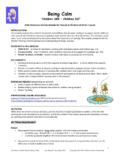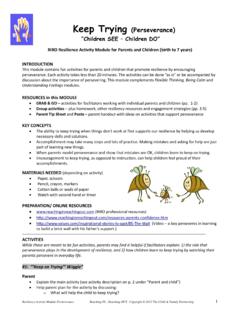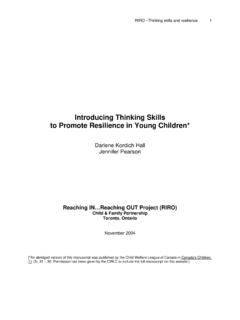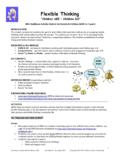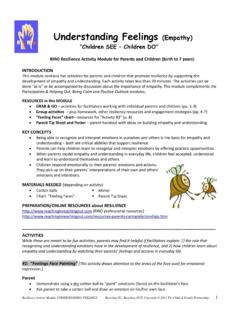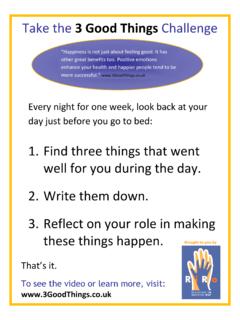Transcription of Overview of Resilience- and Strength-based …
1 APPENDIX E: Annotated Compendium of resilience Measures Compendium of Selected resilience and Related Measures for Children and youth Compiled by Darlene Kordich Hall, Reaching OUT, Toronto (Copyright 2010 The Child & Family Partnership) The 38 measures described in this Overview include those that assess aspects of resilience , life strengths, hardiness and protective/risk factors. resilience oriented measures are described on pages 1 9, general strength based on pages 10 14, hardiness on pages 14 15 and protective/risk factors, pages 16 17.
2 Measures of each type are organized by age group, from pre school to adolescence/young adults. A chart listing all measures in alphabetical order and by target age range is found on pages 18 19. After the description of each measure, two sections with the following information are provided: The conceptual category or higher order categories of resilience measured by the instrument a) individual attributes b) family relationships/cohesion c) external supports the purpose(s) for which the instrument has been created and evaluated a) screening b) profiling/assessing to plan for intervention c) monitoring/measuring change ( , intervention impact) resilience based measures.
3 Pre school to age 5, only 1. Devereux Early Childhood Assessment Program (DECA) (LeBuffe & Naglieri, 1998) For more information, including research bulletins summarizing findings, see the Devereux Foundation, Early Childhood Initiative, . Description: The DECA was developed in the US as part of an intervention program (Devereux Early Childhood Initiative) for 2 5 year olds and has a version for parents and teachers. It is based on the identification of resilience and protective factors captured in 37 items organized into 4 subscales: Initiative (child s capacity to use independent thought and actions to meet their needs) Self control (child s ability to experience a wide range of feelings and to express those feelings in socially appropriate words and actions) Attachment (measures persistent relationships between child and significant adults) Behavior concerns The DECA provides an individual and classroom profile.
4 For each there are specific strategies appropriate for an individual child and for the class as a whole addressing their respective needs. The instrument can also identify children who may be developing behavioral problems. The DECA C (clinical) is a 62 item questionnaire for use and interpretation by mental health and special education professionals to deal with behavioral concerns. It contains the same strengths based items as well as 25 additional items dealing with behavioral concerns such as aggression, attention problems, emotional control, withdrawal/depression, etc.
5 Recently a DECA program for infants and toddlers also has been developed. The DECA program promotes teacher parent collaboration using their joint recognition of the child s strengths to create shared approaches to addressing challenging behaviors and increasing protective factors. 1 2 This measure and the associated program are based on a resiliency framework. The psychometrics are acceptable and the DECA program has been the subject of many studies (most unpublished) with promising results. The measure was standardized on more than 2,000 children in the US.
6 The DECA program is widely used in Head Start programs across the US (the measure is also available in Spanish). It has been chosen as the most suitable among pre school measures in a recent review of measures of socio emotional functioning (Stewart Brown & Edmunds, 2007). It can be used for the early identification and profiling of problematic emotional and social functioning, as well as for monitoring progress made as a result of targeted intervention (p. 252). An added advantage of this measure is its facilitation of the identification of collective needs of a particular class, school or entire school district (p.)
7 253) as well as its intervention strategies and training program for teachers. The Devereux Foundation has also supported development of the DECA-Infant/Toddler Form (DECA I/T) and the DESSA tool for school age children (see below for measures for Elementary school age and older ). Conceptual categories: individual, family & external supports Purpose: screening, profiling for intervention, and monitoring/measuring change Elementary school age and older 2. Devereux Student Strengths Assessment [DESSA and DESSA mini] (LeBuffe, Naglieri & Shapiro) (For more information about the DESSA, see the Devereux Foundation ( ).
8 Description: The Devereux Student Strengths Assessment (DESSA) is a 72 item, standardized, norm referenced behavior rating scale that assesses the social emotional competencies that serve as protective factors for children in kindergarten through the eighth grade (ages 5 14). The DESSA can be completed by parents/guardians, teachers, or staff at schools and child serving agencies, including after school, social service, and mental health programs. The assessment is entirely strength based , meaning that the items query positive behaviors ( , get along with others) rather than maladaptive ones ( , annoy others).
9 For each of the 72 DESSA items, the rater is asked to indicate on a five point scale how often the student engaged in each behavior over the past four weeks. The same form is used for all ages and both parent and teacher raters. The measure is also available for administration and scoring online. The DESSA is organized into conceptually derived scales that provide information about eight key social emotional competencies. Standard scores can be used to calibrate each child s competence in each of the eight dimensions and guide school/program wide, class wide, and individual strategies to promote those competencies.
10 The eight scales are as follows: self awareness, social awareness, self management, goal directed behaviour, relationship skills, personal responsibility, decision making and optimistic thinking. According their website, the DESSA was developed to meet or exceed professional standards for a high quality, well developed assessment instrument. The standardization sample, internal, inter rater, and test retest reliabilities as well as content, construct, and criterion validity evidence are discussed at length in the DESSA manual. The DESSA standardization sample consists of 2,500 children who are representative of the US population with respect to gender, race, Hispanic ethnicity, region of residence, and poverty status.
